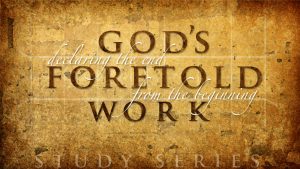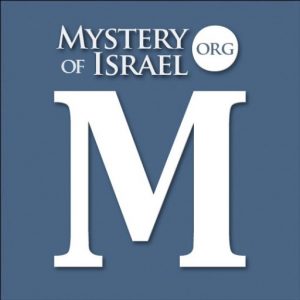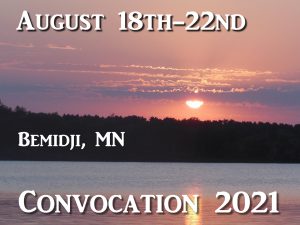Reggie,
I have a question about the Cross, namely how to introduce the topic of the Suffering Servant and the centrality of the Cross for a paper:-) Typically a statement from a brother or an erroneous doctrine will trigger something. But I have been struggling to unite all the threads that we have spoken about in the last couple of weeks to a single precise statement! Which may take years I know:-) Once it pleases the Lord to give us a launching point, I am certain the rest will flow!
Remember that we are speaking here of a particular mystery with a particular source, namely, the writings of the OT prophets. Paul made a careful point of using the prophetic scriptures to make the mystery known, because he understood this approach as God’s specifically appointed means of verification (compare Acts 26:22; Ro 16:25-26; 1Pet 1:11). This was Paul’s method of evangelism, and if you’ll look closely, it appears from Ro 16:25-26 that Paul is saying that this particular method and approach is “according to the everlasting commandment.” In other words, it is the divinely appointed means employed to make all nations obedient. It’s not just one means; it is THE commanded means. So it’s not just that prophecy was useful as proof of Jesus’ messiahship, but that the gospel of a twofold advent was / is to be preached AS a mystery contained in the prophets to be revealed at a set time. But why was it necessary that the prophetic plan of God be so strategically hidden? What is accomplished by such a hiding work? Most people never think of something being hidden for a divine purpose. But if so, what is that purpose?
The revelation of the mystery opens up (‘exegetes’) the mingled prophecies of the two comings, the dual application between the near and far patterns of fulfillment, and the mysterious parenthesis that imposes itself between the two comings of Christ, as also between the typical events of antiquity (near fulfillment) and the anti-typical events of eschatology (ultimate fulfillment; see Dan 9:24-27; Mic 5:1-7; Hos 5:15- 6:2 et al).
By revealing such a mysterious space between foretold events, the mystery of Christ also discovers to our attention an unexpected interim (a hidden age). This time fulfills the mysterious threat of Moses that the elect nation would be moved to envy by a ‘not a people’, and made angry by a ‘foolish nation’ (Deut 32:21). Contrary to replacement views, this is not a permanent state of affairs, but one of the judgments of the curse that continues only UNTIL the time of of Israel’s post-tribulational repentance and restoration (Deut 32:36, 43; Dan 12:7; Mt 23:39; Acts 3:21; Ro 11:25-29).
That is only the ‘linear’ aspects of the mystery. There is also its cosmic and eternal aspect, which finds an everlasting covenant, not only in Israel’s future (as formerly understood), but an eternal covenant that reaches back before the beginning of creation. This opens the Trinitarian issue of Messiah’s pre-existence and deity (Isa 9:5; Mic 5:2; 1Tim 3:16), which in turn opens the soteriological ((Soteriology is the study of the doctrine of salvation as effected by Jesus Christ. It helps us to understand the doctrines of redemption, justification, sanctification, propitiation, and the substitutionary atonement. It is derived from the Greek soterion “salvation”. )) aspect of the promised eschatological ((Eschatology is the study of the ultimate or final things, such as death, the destiny of humanity, the Second Coming, or the Last Judgment.)) righteousness (Isa 45:17, 25; Jer 23:6; 32:40; Dan 9:24 et al). This is perhaps the most glorious of all that pertains to the mystery of Christ, because it means that the very righteousness of God Himself, as perfected in Messiah’s sinless humanity and offered up (Isa 53; Mic 5:2; Dan 9:26; Zech 12:10; 13:7) is freely imputed to the very least justified believer. That is simply staggering! No wonder it is so little understood, believed, adequately appreciated, and rejoiced in forevermore. In the words of Fanny J. Crosby, “I scarce can take it in.” Or, in the words of my beloved Bunyan, “Indeed, this is one of the greatest mysteries in the world; namely, that a righteousness that resides with a person in heaven should justify me, a sinner, on earth!”
Then there is what Paul calls “the mystery of the faith,” which, while it includes all the above, includes also the pattern of resurrection of death, of deliverance out of affliction and weakness. We see it in Joseph, David, Daniel, all the prophets, and ultimately and perfectly in Christ as the suffering Servant of servants. I call it the Jacob’s trouble principle, whereby Christ is always revealed at the end of strength (see Deut 32:36; Dan 12:7). This is how it is that “the just shall live by faith” This is particularly the issue in tracing the character and necessity of Israel’s king as coming first in the form of the suffering Servant. This is the pattern seen so clearly in both Joseph and David, and in Zechariah’s prophecy that sees the Messiah as a priest upon His throne (Zech 6:13). It is the tremendous mystery of the incarnation of the seed of the woman in the poor and afflicted. This should be to some real measure evident in every believer, since it is the mystery of “Christ in you” (Col 1:27), just as it was no less the mystery of “the Spirit of Christ which was in them” (1Pet 1:11).
Indeed, the mystery is so rich and manifold. It is all so glorious and expansive. Its waters only deepen with every new measure (Ezek 47:3-5). It’s glory cannot be contained, so it is understandable why it is not easy to see all of its parts at once in full conspectus ((Conspectus – usually a brief summary of an extensive subject, often providing an overall view.)) This explains why the all inclusive “mystery of God” that comes to completion at the time of Christ’s return (Rev 10:7; 11:15) is treated by Paul in so many different aspects. This gives the superficial impression of multiple mysteries. When really, most of Paul’s references to one mystery or another is just one more aspect of the greater mystery of God and Christ (Col 2:2), which he calls the “mystery of His will” (Eph 1:9) or the “eternal purpose” (Eph 3:11).
The important thing to note, and which makes it impossible to associate Paul’s use of the term with any supposed borrowing from notions of Greek gnosticism (as alleged by certain liberal theologians) is that Paul insists that the mystery that he preached was fully foretold in the prophets (Acts 26:22; Ro 16:25-26). This casts serious question on any alleged Pauline mystery that cannot authenticated by what was foretold in the prophets. The fall and rising again of Israel is built around this core mystery of Christ’s twofold advent. The calling out of the gentiles is also predicated on the same essential revelation.
So why subscribe to a theology that denies the resurrection and restoration of Israel at Christ’s return? That’s not the mystery that Paul preached. And why subscribe to a so-called “mystery church age”, which demands an entirely separate entity with a separate destiny from Israel? This, of course, requires its own sub set of mysteries, such as a special rapture, which amounts to a separate resurrection that is seven years earlier from the faithful of Israel (see Job 19:25; Isa 25:7; 26:19; Dan 12:2; Jn 6:39-40, 44, 54; 11:24; 12:48). No such mystery can be shown or verified by anything foretold in the prophets.
It was apostolic policy that if the testimony did not conform to what stood written in the OT scriptures, it was not to be believed. Any other alleged mystery would have been dismissed as characteristic of the Greek mysteries, which were a far remove from Paul’s use of the term. No, his approach to the mystery of the gospel (Eph 6:19) was the same as the ‘mystery of the kingdom’ introduced by Jesus, which could only be understood in light of His twofold coming. Then, of course, there was Isaiah’s testimony of a secret Torah (teaching) or ‘sealed book’ that was to be “shut up and sealed (Heb. “held under wraps” Keil and Delitzch) among my disciples (Isa 8:14-17; 28:9-18; 29:10-14; Hab 2:2-3; Dan 9:24; 12:4, 9). The question is: who’s disciples? Isaiah’s or Christ’s? Christ, of course. I see this as OT background to the Lord’s explanation that the parables were not for “those outside” but for His disciples only (Mk 4:11). This theme of the so-called ‘messianic secret’ that runs all through the gospels has been a real source of speculation and puzzlement among NT scholars with many inadequate and unsatisfying solutions proposed.
It cannot be denied that Jesus was the custodian of a hidden knowledge by which He would justify the many (Isa 53:11). The secret would be revealed to the disciples by the Holy Spirit only AFTER its accomplishment. Until then, it was strictly ‘see thou tell no man’ (Mk 8:4, 30; 9:9). This is the God of Israel who hides Himself (Isa 45:15) from both the pride man (Mt 11:25; 1Cor 2:14), and the angelic rulers that stand behind all worldly powers. “But we speak the wisdom of God in a mystery, even the hidden wisdom, which God ordained before the world unto our glory: Which none of the princes of this world knew: for had they known it, they would not have crucified the Lord of glory” (1Cor 2:7-8). This means that while Satan knew a great deal, he did not know the mystery of God’s secret intention. By the time he knew it, it was too late.
The mystery was hidden even from the righteous until the appointed time (Mt 16:22; Acts 1:6; 3:18-21; Ro 16:25; Eph 3:5; Col 1:26; 1Pet 1:11-12). Now that the mystery of Christ is an ‘open seceret’ to be proclaimed from the house tops to every creature under heaven, we should not lose appreciation for the glory of God’s awesome strategy in its execution both then and at the end, since it is still hidden from the natural man (1Cor 2:14).
True knowledge of God’s eternal purpose and the strategy by which it is accomplished does not encourage pride, as in the esoteric knowledge of the Greek Gnostics. Paul’s understanding of the term mystery comes from a completely Jewish background and is of a very different nature. I find no point of intersection with Greek thought at all. You’ll see some of this discussed in your studies of NT backgrounds. Rather, the quickened apprehension of true revelation of the mysteries of God makes one a privileged servant and steward (1Cor 4:1; 9:17; Eph 3:2; Col 1:25) ).
But most of all, insight and understanding of the glory of God’s hidden wisdom designs to cast down pride (Isa 6:5; Acts 9:4; Zech 12:10-11) and exalt the glory of God into new realms of praise and worship (Ro 11:33-36). God’s mystery is not for the wise and prudent but for babes (Mt 11:25). It is not for the world (Jn 14:17); the secret of the Lord is simply for the friends of God (compare Gen 18:17; Isa 41:8; Ps 25:15; Prov 25:2; Amos 3:7; Dan 2:30; Mt 13:11; Jn 15:15; Rev 10:7).
It is the glory of “this mystery” (Ro 11:25) that breaks so powerfully upon Paul (Ro 11:33-36) as he traces the paradoxical twists and turns of salvation history in his grand overview in Ro 9-11. Thus, true revelation of the hidden wisdom of God (of which the cross must always be the centerpiece), should not minister pride, but awed worship of the glory of God. If there is pride, it is testimony that the true nature of God’s mystery has not really been apprehended in truth, since to ‘see’ truly guarantees change into greater degrees of Christ likeness (2Cor 3:18). To truly see is to be truly changed. It is one thing to know a lot ‘about’ something; it is something else altogether to be apprehended by a true seeing. That is why I know that when Daniel speaks of those that “understand among the people,” he means something far more profound than a mere knowledge of end time happenings.
That’s some seed for thought. I’m going to send this out on my list of contacts, not only to give others a peak at what we’ve been discussing over the phone, but to invite their input. If God’s people help each other, no telling what we can enjoy in the way of greater clarity and simplicity in these rich but often difficult themes and truths. No wonder Paul begged the prayers of the church that he would be granted “utterance to make known the mystery of the gospel” (Eph 6:18-19), and to make all men see “the fellowship of the mystery” (Eph 3:9). I personally believe that a clear grasp and prepared understanding of the mystery in its major parts would transform the church’s witness to Israel, and no less the nations. I have that conviction, so we labor in faith.
Your ever devoted brother, Reggie
PS.
After our review over the phone of the basic structure of the mystery, the ‘already and the not yet’ etc. What do you propose as a central thesis statement that can be a starting point from which to “unite all the threads”? I used to talk to Art all the time about the need to pull all the strands together into a coherent whole. He loved that kind of talk and that was his aspiration in what we were planning in the way of what we called “table talks” planned for that following summer. So how do you propose we proceed to make this vision plain upon tables (simplified) so that everyone that reads (truly reads) is constrained to become a runner?




